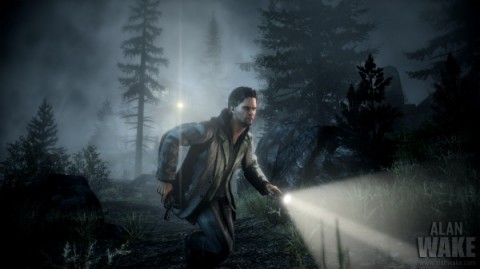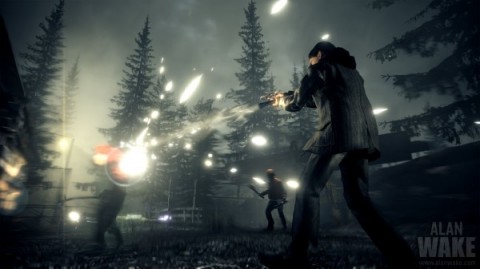Alan Wake review
 Alan Wake, the new thriller game from Remedy exclusively on the Xbox 360, has been a long time in the making. In fact, the last game Remedy put out was the classic 3rd person shooter Max Payne 2, a good seven years ago. This time around, the focus is less on all out action and more on giving the viewer (erm – the player) the creeps. Does it pay off?
Alan Wake, the new thriller game from Remedy exclusively on the Xbox 360, has been a long time in the making. In fact, the last game Remedy put out was the classic 3rd person shooter Max Payne 2, a good seven years ago. This time around, the focus is less on all out action and more on giving the viewer (erm – the player) the creeps. Does it pay off?
The eponymous hero of Alan Wake isn’t the typical tough guy. In fact, he starts off as a bit of a big city jerk. A well-known horror writer who’s been suffering from writer’s block for two years, he takes off with his wife for the remote town of Bright Falls, located in Washington state, somewhere between Twin Peaks and an X-Files set, where they’ve rented a cabin to get some peace and quiet. The locale reeks, in a good way, of the atmosphere found in those two shows, with quirky characters in a rustic setting surrounded by dense woods and mountainous terrain. After arriving at the cabin, Alan and Alice get into an argument, leading him to step outside into the night air to calm down. It’s at this point when the weirdness kicks into high gear, as Alice goes missing, and in his attempt to rescue her, Alan is knocked unconscious. He wakes up some time later to find her gone, and the first few pages of a new manuscript that he has no memory of writing.
I know I’m far from the first to mention television show comparisons, and it’s with good reason. The presentation of the game is modelled after a season from an ongoing TV series, with the game divided into 6 episodes, starting with a ‘Previously on Alan Wake…” recap, and ending on a cliffhanger. Though not entirely new, the presentation feels authentic, and the goal of wrapping a video-game in a television like framework comes off without a hitch. All of this style wouldn’t work without a good script.
That’s what makes it work. The story is solid, if not completely original, as the idea of a horror writer whose story comes to life has been done before. One of the best examples of the combination of game mechanics and storytelling is the manuscript. As you progress through the episodes, you find individual pages that tell the very story you’re playing through, sometimes after you’ve experienced the events, and sometimes before. In the latter case, this does wonders for creating a sense of dread. After all, when a page ends with a line like “that’s when I heard the roar of the chainsaw…” (paraphrasing here), and knowing that it could happen at any time, well, it works. The manuscript device, along with the combination of interactive cut scenes and full on action/horror gameplay is well paced, and generally structured so that most of the action happens in the last half of each episode.
The environments in Alan Wake are lovingly crafted, both visually and aurally. In particular, the sound design, both environmental and the soundtrack, is worth pointing out, and help establish a menacing reality knocked just a little sideways while maintaining a subtle realism. That, and some of the licensed music, such as Nick Cave, is truly inspired.
Speaking of ‘inspired’, throughout the game, you’ll also find nods to other horror/suspense classics, from a car that looks too much like Ash’s Delta 88 in the Evil Dead films, to a Twilight Zone inspired TV show called “Night Springs”, episodes of which are viewable on TV screens found in game (some of them darkly hilarious in their own right). There’s also a few genre tropes thrown in there, including the classic jump scare of a cat screeching and crashing into a garbage can.
Each building you enter feels like a real place, as if Remedy went out and found the quintessential small north western town and rebuilt it with loving care just for the game. It feels like people really live in Bright Falls, and even the minor characters have their idiosyncrasies, without being too over the top. In both characters and environments, Remedy has done a good job in crafting what feels like a real place. From the town to the decrepit logging buildings you encounter on your adventures in the forest, they’re chalk full of little details to sell the authenticity of the space.
This goes double for the forest where most of the action takes place. The woods feel alive with personality. What seems so inviting during the day becomes foreboding and haunting at night, with shadows from the moon light casting irregular shadows and odd silhouettes. This is further realized by the sounds of nature, from the rustling of leaves in the wind and the ubiquitous insects punctuated by the occasional lonesome hoot of an owl or a coyote in the distance. The forest feels alive like no other forest I’ve played in a game before.
When the game turns towards the supernatural, the forest takes on an even darker character, the darkness distorting shadows, and the wind whispering threateningly, and throwing up a swirling mystical fog around you. Was that one of the taken stepping behind a tree, or just a trick of the moonlight? The forest left me questioning myself more than once.
When the shadows do turn out to be enemies in the dark, they’re mainly comprised of people who’ve been taken by ‘the darkness’. The darkness renders them impervious to normal weapons until this darkness is removed from them. Your flashlight becomes your best friend here, as you’ll need it on high to burn away the darkness, so keep an eye on your battery supply. Once the darkness retreats from a foe in a burst of sparks, you’re free to take him down with more conventional weapons. The selection of weapons isn’t too great, which makes sense given the story, and all the main bases are covered. In essence, you’re fighting two handed here, and in some particularly tight situations I felt myself panicking and holding onto the flashlight’s high-beam for much longer than needed.
Another nice combat mechanic is the left button dodge, which gives a satisfying temporary slow-mo effect when properly executed. The dodge is a necessity, especially on Nightmare mode, as Alan Wake does fall into that common 3rd person problem of camera placement. I’ve found myself more than once to be in a place where a dodge away from the camera saving my bacon more than once. To be fair, I’ve played any number of games with less complex environments and more camera issues, so I may be a little nitpicky here. I don’t think anyone has perfected the 3rd person camera yet.
Other than that, the variety of combat is just enough to keep you from getting bored, as new elements are added in each episode, from flare guns and more powerful flashlights, to new standard weapon types. Vehicular combat is thrown into the mix at certain points, with generally positive results. The car controls are a little sloppy, but not too bad, and the satisfaction of watching the darkness scatter from a cluster of foes at once is downright relieving. The ‘darkness’ is also capable of possessing vehicles and other inanimate objects as well, which can be downright creepy when you’re walking though a misty logging site in the middle of the night surrounded by massive pieces of equipment.
Though the story is linear, there are rewards for exploring off the beaten path, such as some of the aforementioned TV sets, as well as radios, both of which add texture to the world presented. There are also coffee Thermos’ scattered in odd locations, for the true collectors out there. I couldn’t help but wish there was more to the side exploration than these perks and a few Gamerscore points, something more intrinsic to the gameplay, but it’s a minor complaint at the most. Most of the manuscript pages are close to the main path, though I almost missed a few on my run through. There are also a few pages to fill in the blanks that you can only collect on Nightmare mode, so if you’re not the type of person who’s heavily into replaying a game, you might want to challenge yourself right out of the gate. It certainly makes combat challenging for the hardcore gamer, while the easier modes will be more than enough for the more casual player.
For all the good in the game, it’s not flawless. First, it’s a relatively short game, and with no multiplayer it doesn’t offer much in the replayability factor. Although the character modelling is well done, the same can’t be said for the lip sync. A lot of it works, but there are points where it seems whole chunks of keyframes are missing, leading to the rubber jaw effect. It‘s not the worst I’ve seen, but in a game that depends so much on selling you fully realized characters, such minor distractions become much more noticeable.
Final Thoughts: Alan Wake is a well-crafted piece of supernatural suspense, that strikes a good balance between storytelling and a unique combat mechanic that not only works well from a technical point, but fits in with the moody and evocative tale. Everything about the game is designed to pull you into the world of Alan Wake and make you believe it’s real. In fact, it’s almost as much fun to watch as it is to play. Remedy isn’t trying to create the next level of interative fiction in videogames, they’re concerned with telling you the story they want, and pulling no punches, borrowing from multiple genres and mediums to do it.
When it’s biggest fault is that it’s too short of a game, that’s not much fault at all.
Alan Wake is available, in both regular and Limited Edition versions, for the Xbox 360 in North America as of today (except Australia, which will have to wait a couple of days.)
UPDATE: It’s also worth mentioning that the game comes with a code to download, for free, a new episode called the “The Signal”, which will be released on July 27th. There’s little detail on the DLC, though it’s possible that beside extra story content, it may correct the facial animation issues mentioned earlier…
We have a few different methods of doing facial animation – in-game using FaceFX and motion capture used in cinematics. While I think it’ll always be possible to get “fugly” single frames out of any game we definitely learned a lot doing Alan Wake, and will try to improve the way we do things to get best possible looking facials. In fact, we’re using some of the improvements in the DLC production already.
It’s not alone a matter of the method how or where the facial capture is done, it’s about the run-time animation techniques available, skeleton setup and so on. It’s a complex problem trying to dodge the Uncanny Valley. [forum post from Remedy’s Markus Maki]
Finally, if you haven’t watched it yet, the “Bright Falls” prequel has had the final episode published online, so if you’re considering the game, you might want to head on over to Bright Falls and get in the mood.



















[…] week, The Signal DLC came out for Alan Wake. The only problem is that you can’t play the DLC without the game. To help one lucky […]